Premium Only Content
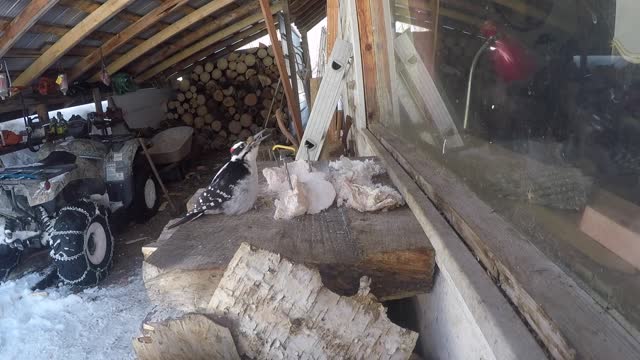
Hairy Woodpecker doin his thing
Then he stands up to look, its at me sitting down on the recliner to have a coffee. They can see through the window. Its best to keep the window dirty other wise the birds will be thumping into them like theres no tomorrow.
Conservation status: Although still very widespread and fairly common, thought to have declined from historical levels in many areas. Loss of nesting sites (with cutting of dead snags in forest) is one potential problem. Starlings and House Sparrows may sometimes take over freshly excavated nest cavities.
Family: Woodpeckers
Habitat: Forests, woodlands, river groves, shade trees. Accepts wide variety of habitats so long as large trees present; found in deciduous, coniferous, and mixed forest, groves along rivers in prairie country, open juniper woodland, swamps. In southwest and from Mexico to Panama found in mountain forests, mostly of pine, but also in cloud forest in Central America.
This species and the Downy Woodpecker are remarkably similar in pattern, differing mainly in size and bill shape. They often occur together, but the Hairy, a larger bird, requires larger trees; it is usually less common, especially in the east, and less likely to show up in suburbs and city parks. In its feeding it does more pounding and excavating in trees than most smaller woodpeckers, consuming large numbers of wood-boring insects.
Feeding Behavior
Forages mainly on the trunks and limbs of trees, sometimes on vines, shrubs. Energetic in its search, often probing, scaling off bark, and excavating into dead wood in pursuit of insects. Males may forage more deliberately than females, working longer in one spot.
Eggs
4, sometimes 3-6. White. Incubation is by both sexes (with male incubating at night, female most of day), about 14 days. Young: Both parents feed the nestlings. Male may forage farther from nest, making fewer feeding trips with more food each time. Young leave nest 28-30 days after hatching, are fed by parents for some time afterward. 1 brood per year.
Diet
Mostly insects. Feeds especially on larvae of wood-boring beetles, also other beetles, ants, caterpillars, and others. Also eats some berries, seeds, nuts. Will feed on sap at damaged trees or at sapsucker workings, and will come to bird feeders for suet.
Nesting
Male and female may maintain separate territories in early winter, pairing up in mid-winter, often with mate from previous year. Female's winter territory becomes focus of nesting territory. Courtship includes both birds drumming in duet; ritualized tapping at symbolic nest sites by female. Nest site is cavity (excavated by both sexes), mainly in deciduous trees in east, in aspens or dead conifers in west. Cavity usually 4-60' above ground.
Like, share, and subscribe or better yet donate some bitcoin or silver. Leave a comment below, Enjoy.
Bitcoin address: 1NY3dnB7MpwbHWLSN7cSf39h2VmE2PnTAi
PMB 284 230-1210 Summit Drive
Kamloops BC Canada
V2C6M1
-
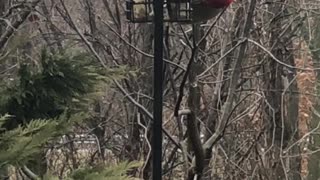 0:09
0:09
Cgenus1
4 years agoRedBelly Woodpecker
13 -
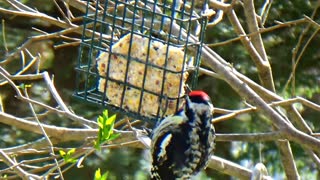 0:36
0:36
NewHampshire603
4 years agoSapsucker Woodpecker
19 -
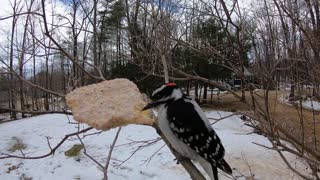 0:13
0:13
NewHampshire603
4 years agoDowney Woodpecker
193 -
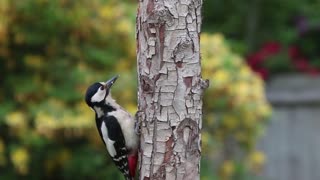 0:33
0:33
zibik
4 years agoMy woodpecker
72 -
 LIVE
LIVE
Matt Kohrs
5 hours agoStock Market Open: Bulls Push For New Highs || Live Trading Futures
660 watching -
 LIVE
LIVE
Wendy Bell Radio
4 hours agoSay Their Names
7,402 watching -
 LIVE
LIVE
LFA TV
3 hours agoLFA TV ALL DAY STREAM - TUESDAY 9/9/25
6,618 watching -
 1:13:16
1:13:16
JULIE GREEN MINISTRIES
3 hours agoTHINGS THAT WERE BURIED IN YOUR CAPITAL HAVE BEEN FOUND
68K149 -
 LIVE
LIVE
JuicyJohns
1 hour ago $0.29 earned🟢#1 REBIRTH PLAYER 10.2+ KD🟢
89 watching -
 19:37
19:37
BlaireWhite
1 day agoWe Need To Talk About The Trans Shooter, "Robin" Westman.
4.72K10